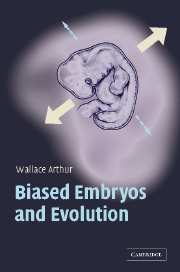Book contents
- Frontmatter
- Contents
- Preface
- Acknowledgements
- 1 The microscopic horse
- 2 What steers evolution?
- 3 Darwin: pluralism with a single core
- 4 How to build a body
- 5 A brief history of the last billion years
- 6 Preamble to the quiet revolution
- 7 The return of the organism
- 8 Possible creatures
- 9 The beginnings of bias
- 10 A deceptively simple question
- 11 Development's twin arrows
- 12 Action and reaction
- 13 Evolvability: organisms in bits
- 14 Back to the trees
- 15 Stripes and spots
- 16 Towards ‘the inclusive synthesis’
- 17 Social creatures
- Glossary
- References
- Index
11 - Development's twin arrows
Published online by Cambridge University Press: 02 December 2009
- Frontmatter
- Contents
- Preface
- Acknowledgements
- 1 The microscopic horse
- 2 What steers evolution?
- 3 Darwin: pluralism with a single core
- 4 How to build a body
- 5 A brief history of the last billion years
- 6 Preamble to the quiet revolution
- 7 The return of the organism
- 8 Possible creatures
- 9 The beginnings of bias
- 10 A deceptively simple question
- 11 Development's twin arrows
- 12 Action and reaction
- 13 Evolvability: organisms in bits
- 14 Back to the trees
- 15 Stripes and spots
- 16 Towards ‘the inclusive synthesis’
- 17 Social creatures
- Glossary
- References
- Index
Summary
It's now time to bring development back into the picture in a more explicit way. As we noted in the previous chapter, internal selection can occur based on fitness differences between adults, so there is no logical necessity for this process to be linked to development other than for the obvious reason that adults arise through the developmental process. But there is another angle on all this, which does indeed suggest that internal selection and development may have a particularly close relationship.
By the way, you will notice that I have debunked both ‘internal’ and ‘external’ selection in their pure forms, yet here I am starting to use these terms again as if I don't believe my own argument for a continuum. I must therefore stress that I do believe my argument, but I also need to be able to write in a relatively straightforward, non-cumbersome way. So phrases like ‘selection in which 75 per cent of the fitness difference is due to a difference in internal integration and 25 per cent due to the interaction with the environment’ are not the best way forward. So from here on, please interpret ‘internal selection’ as meaning predominantly internal, and likewise for ‘external’.
Suddenly it begins to matter which type of creature we are dealing with. Although evolutionary theory, like all science, should be as general as possible, and although the idea of selection (internal and/or external) can be applied to any type of creature, there are some things in relation to which we have to be careful not to overgeneralize. And what follows is one of them.
Information
- Type
- Chapter
- Information
- Biased Embryos and Evolution , pp. 127 - 138Publisher: Cambridge University PressPrint publication year: 2004
